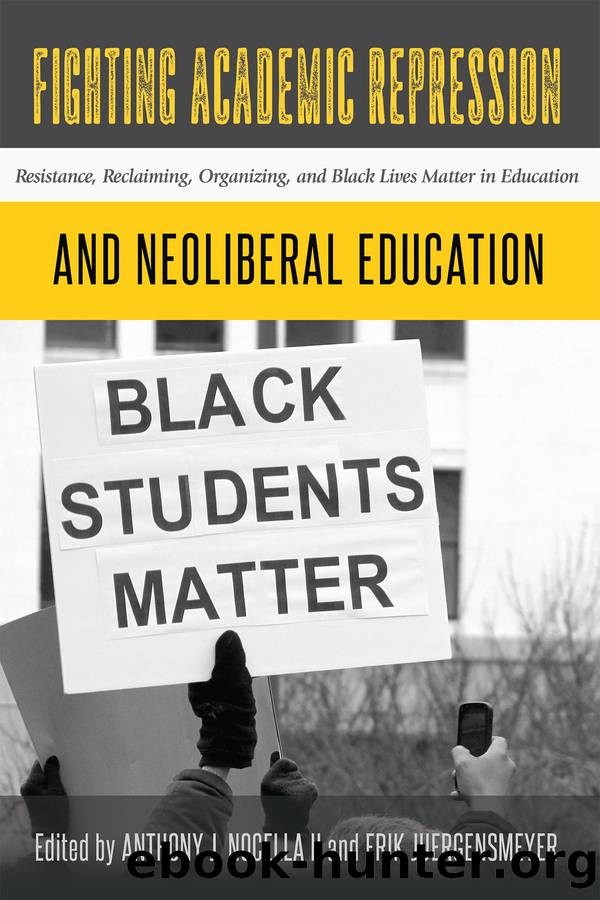Fighting Academic Repression and Neoliberal Education by Nocella II Anthony J. / Juergensmeyer Erik

Author:Nocella II, Anthony J. / Juergensmeyer, Erik
Language: eng
Format: epub
Publisher: Peter Lang Publishing, Inc.
A BRIEF WORD ON ACADEMIC AND POLITICAL REPRESSION
The primary forms of repression employed by administrations are a combination of administrative and legal coercion aimed at diminishing the use of disruption tactics among students. Off campus actions, such as the Mall of America sit in or highway lockdowns during the UCâs 96 Hours of Action, tend to result in formal detainment by the police, lengthy court hearings with steep legal charges (frequently necessitating the redirection of resources to legal funds). Similar outcomes are also common on campus with an additional layer of internal review regarding whether or not the student will be allowed to continue with his or her degree. However, what is frequently missed is how the role of intimidation in regulating campus space is used to limit social activity. There is perhaps no better example of this than the increasingly popular âfree speech zoneâ designations that require students obtain a permit from administrators in order to access spaces outside a predefined area. Breaking these rules commonly results in the use of unnecessary force (i.e., beatings, detainment, and legal charges). This is equally true in Western countries (e.g., the UC Pepper-spray incident 2011) as it is elsewhere (e.g., Indian police use of live ammunition on the student strikes opposing a World â 132 | 133 â Trade Organizaton/General Agreement on Tariffs and Trade agree last year or the ongoing beatings of student crowds in Chittagong, Bangladesh).
More broadly, student representation on the vast majority of campuses is assumed by service-oriented student government structures that primarily serve as a sort of rotating figurehead who builds credentials for aspiring elites while lacking real institutional power. This is immediately felt within the marginalizing effect of bureaucracy on those seeking to create real institutional change (especially institutions which do not bother to maintain the charade of student governments). It is in this institutional context that police forces have militarized on campus to maintain control of crowds of students, whether as campus police or national paramilitary.
When students refuse to cooperate with authorities in whatever capacity, whether the forced removal of a sit in or violent clash in the streets, power is asserted through physical violence upon the student. Although similar, this spectrum of repression has been discussed by others in extensive detail, both on and off campus (Nocella II, Best, & McLaren, 2010). It is hard to articulate the brutality which occurs throughout parts of the global south. Instances such as the disappearances of student organizers in Sri Lanka and Ayotzinapa, Mexico, as well as elsewhere throughout the world, represent perhaps the most drastic form of political repression. Neglecting years of similar examples, the bloodshed perpetrated in India during the OccupyUGC campaign alone is of serious international concern. Much like those killed within the struggle of other radical social movements, whether the faces of the forty-three missing Mexican students, Alexandros Grigoropoulos in Athens, Greece, or Prosenjit Sarkar at NIT Durgapur in Nepal, India, loss of life has a way of galvanizing the participation of a critical mass.
Download
This site does not store any files on its server. We only index and link to content provided by other sites. Please contact the content providers to delete copyright contents if any and email us, we'll remove relevant links or contents immediately.
The Art of Coaching Workbook by Elena Aguilar(48577)
Trainspotting by Irvine Welsh(20143)
Twilight of the Idols With the Antichrist and Ecce Homo by Friedrich Nietzsche(17758)
The Secret History by Donna Tartt(16763)
Cat's cradle by Kurt Vonnegut(13955)
Ready Player One by Cline Ernest(12933)
All the Missing Girls by Megan Miranda(12838)
Talking to Strangers by Malcolm Gladwell(11991)
Fangirl by Rainbow Rowell(7895)
Thirteen Reasons Why by Jay Asher(7857)
The Compound Effect by Darren Hardy(7640)
The remains of the day by Kazuo Ishiguro(7623)
Periodization Training for Sports by Tudor Bompa(7378)
The Lover by Duras Marguerite(7167)
Wonder by R. J. Palacio(7127)
Tools of Titans by Timothy Ferriss(7024)
Change Your Questions, Change Your Life by Marilee Adams(6704)
The Complete Stick Figure Physics Tutorials by Allen Sarah(6677)
The Leavers by Lisa Ko(6516)
